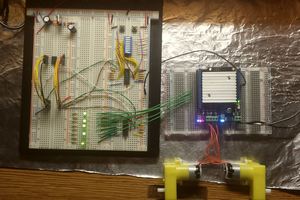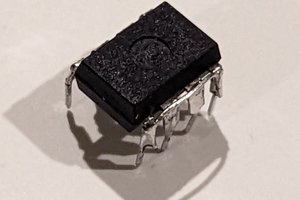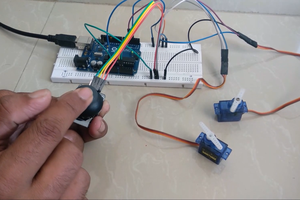Full Arduino sketch (works on Due): https://gist.github.com/summivox/cfbcb8d309d416cefc3c0df10379339f
Interface with Shifter
This unit is kinda special as it can act as either an H-pattern or a sequential shifter:
- The H-pattern mode should be presented as 1 button for each gear: 7 forward and 1 reverse. Neutral is represented by all buttons released.
- The sequential mode should be presented as 2 buttons: shift up and shift down.
- A push/pull lever near the bottom of the base selects the mode.
After some googling I found a legit looking pinout / schematic in a forum post:
- GND
- low = H-pattern, high = sequential
- internally shorted to pin 2
- X axis (H-pattern); lever push (sequential)
- Y axis (H-pattern); lever pull (sequential)
- VCC
Pin numbers are for RJ12 (6P6C).
Just to be safe though, I opened the shifter up to make sure that VCC and GND matches the pinout listed above. The trick is to locate the power and ground pins on ICs:

The chip on the left is an MCP6N11-010, an amplifier. Knowing its pin 4 is GND and pin 7 is VCC, some continuity checks is enough to confirm the pinout.
While I don't have any RJ12 jacks/plugs around, the shifter does come with two cables --- one RJ12-to-RJ12 for connecting the shifter to "modern" Fanatec wheels, and one RJ12-to-PS/2 for "legacy" wheels. I don't have any so I decided to turn the legacy cable into a pigtail. Well, not quite a pigtail --- I happen to have an IDC header around so I just shoved the individual wires into the header and clamped it down.
Now with a cable, I fired up my bench power supply and scope to inspect the outputs:
- In the H-pattern mode, X axis continuously tracks the left-right angle of the stick, while the Y axis has 3 discrete states: forward, center, and backward.
- In the sequential mode, both "X axis" and "Y axis" outputs are active-low discrete signals (simple button). Pushing the stick makes "X" go low; pulling makes "Y" go low.
Sounds pretty simple. I slapped on some naive debouncing logic and logged everything through serial. Looks to be working.
USB HID gamepad on Arduino Due
I simply pulled in the Arduino Joystick Library. It works out of the box.
BTW: This is why I am reluctant to use STM32, my all-time favorite MCU series, for anything USB. Instead of over-complicated proprietary "middle-ware" on under-documented hardware, I'd rather have a simple open-source library that gets the shit done.
Limitations
I did not include any calibration capability for the H-pattern mode. Everything is hard-coded. While this is okay for the Y axis since it only has 3 states (high, mid, low), the X axis is more crowded and MIGHT be different from unit to unit. If the hard-coded constants are not good enough for you, simply upload an analog input logger sketch and figure out the correct values yourself.
 Yin Zhong
Yin Zhong





 Shranav Palakurthi
Shranav Palakurthi

 Mild Lee Interested
Mild Lee Interested
i followed your project using a generic leonardo r3 and im not able to get any input read. i changed the first line from cstdint to stdint.h, and commented out analogreadresolution as they were both causing errors for me. i then followed your pinout putting P2 to A2, P4 to A0, P5 to A1, P1 to GND P6 to 3.3V. i uploaded the sketch fine, and my pc detects the leonardo as a usb game pad and sees the shifter inputs as buttons, but input from the shifter is not doing anything. if you could provide any guidance on if i made an error with the pins, or if i need to use readresolution somehow, it would be much appreciated!